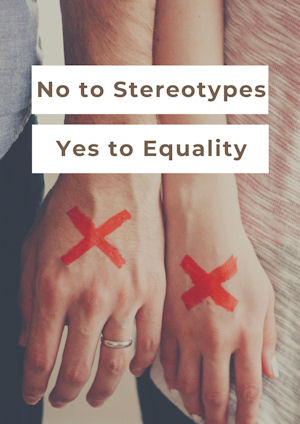You CAN have a wedding free of gender-role stereotypes
Categories: | Inclusive Weddings | Wedding Ceremony |
 The traditional wedding ceremony is
heavily loaded with gender-role stereotypes. Even
today, while society is becoming more and more
gender-neutral, gender and stereotype laden
ceremonies are the norm.
The traditional wedding ceremony is
heavily loaded with gender-role stereotypes. Even
today, while society is becoming more and more
gender-neutral, gender and stereotype laden
ceremonies are the norm.I used to find that couples, expecting a highly gendered ceremony before Marriage Equality became a reality in late 2017, were surprised to find that they could choose to use the gender-neutral word spouse, in place of husband and wife. Brides were not legally required to be given away. Nor were they legally required to be the passive recipient of The Kiss with no say in the matter, the groom being given permission to kiss his (or worse, the) bride.
What did Marriage
Equality change?
out
The obvious change (yay) was that the couple
standing up in front of their guests, pledging
their lives to one another, do not have to be
one female bride and one male groom. You can be
who you are, the gender you are, regardless of
the gender of the person you want to spend the
rest of your life with. As a result, the
definition of marriage, required to be recited
by every civil celebrant before a couple makes
their vows, saw a man and a woman
changed to two people.A second positive change was to the terminology you can use when you make your vows.
The option of taking your best beloved as your husband, or wife, remains. So you can marry as husband and wife, husband and husband, or wife and wife. The option of using the gender-neutral word, spouse, also remains.
A new gender-neutral term was added. Couples can now pledge their lives to one another as partner-in-marriage. Interestingly, while pre-Marriage Equality the use of the word partner was not permitted in a legal marriage ceremony, due to the ambiguity of the term, it was the term of choice for same sex couples having a non-legal wedding (commitment ceremony). Post Marriage Equality, same sex couples appear to overwhelmingly favour the use of husband and husband or wife and wife (and why wouldn't they, having fought so hard for it), a significant proportion of the heterosexual couples I marry are choosing to say partner-in-marriage.
It follows that you can, and should, feel comfortable with using your pronouns, whatever they are.
What about the
paperwork?
Marriage Equality changed the column headings from Bridegroom and Bride to Partner 1 and Partner 2 (allowing you to decide who would be which) and removed those terms from the Presentation Certificate.
Two sets of checkboxes were added to the Notice. How you chose to describe yourselves (Groom, Bride, or Partner) and your sex (Male, Female, X). So there was still a whisper of the previous hierarchy in the order ... but the good news is that the term sex has been discarded in favour of gender and non-binary now replaces X , so the options will be male, female, non-binary. Providing gender information is optional, and will not transferred onto your marriage certificate. It is for statistical purposes only.
On your official marriage certificate the term you choose (Groom, Bride, or Partner), and only that, will appear. Your gender is not mentioned.
Making sure your
ceremony isn't traditionally gendered
- your wedding party doesn't have to be divided along strictly gender lines
- there are many more ways of getting yourselves up the front than one person walking towards the other
- one of you does not have to be given away to the other
- you can wear whatever you like without any regard to heteronormative styling.
Related posts
- Your wedding party - busting the myths
- You, Your Wedding, and Trans-Gender and Non-Binary Inclusivity
- Getting
married when you don't identify with a
gender
- Bride promising to obey until death? Not any more
- 'You may kiss your bride'
- Same Sex Ceremonies - Negotiating the Gendered Nature of Ceremony Traditions

0 Things